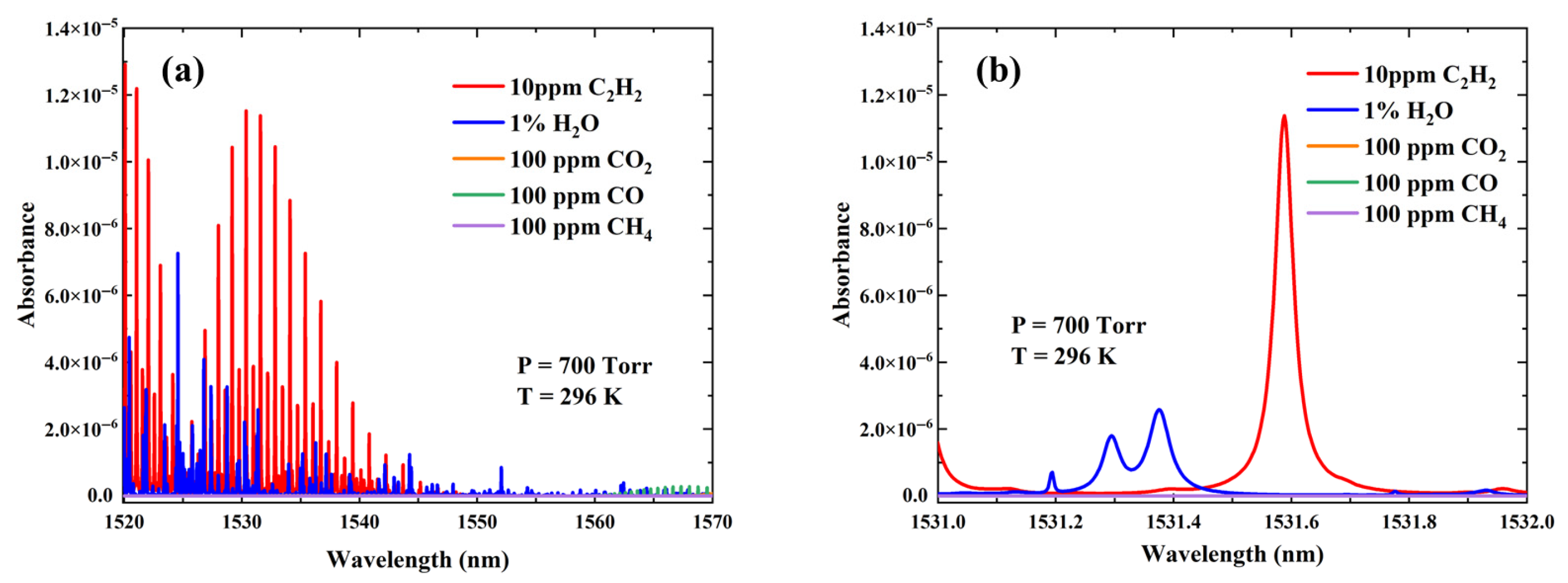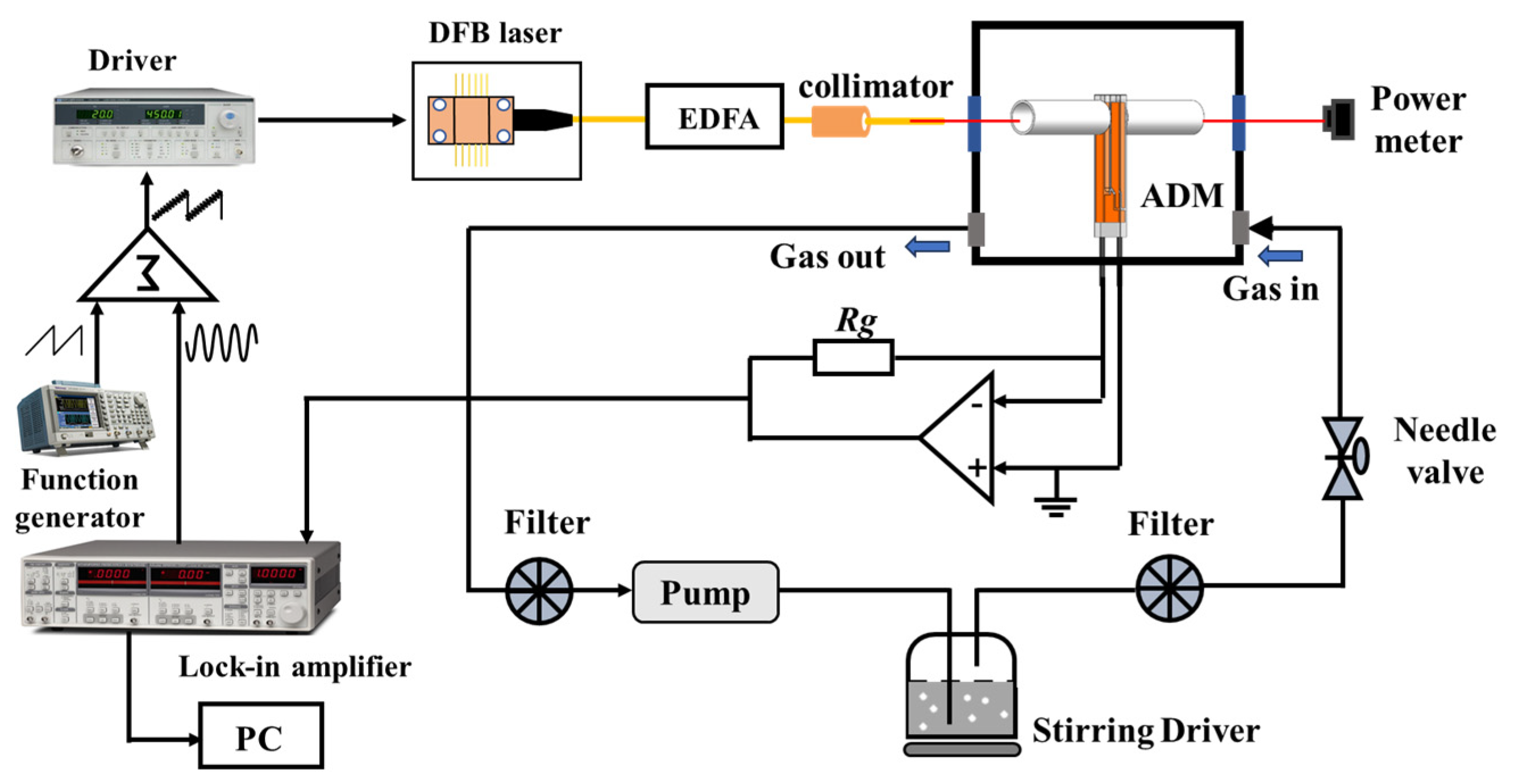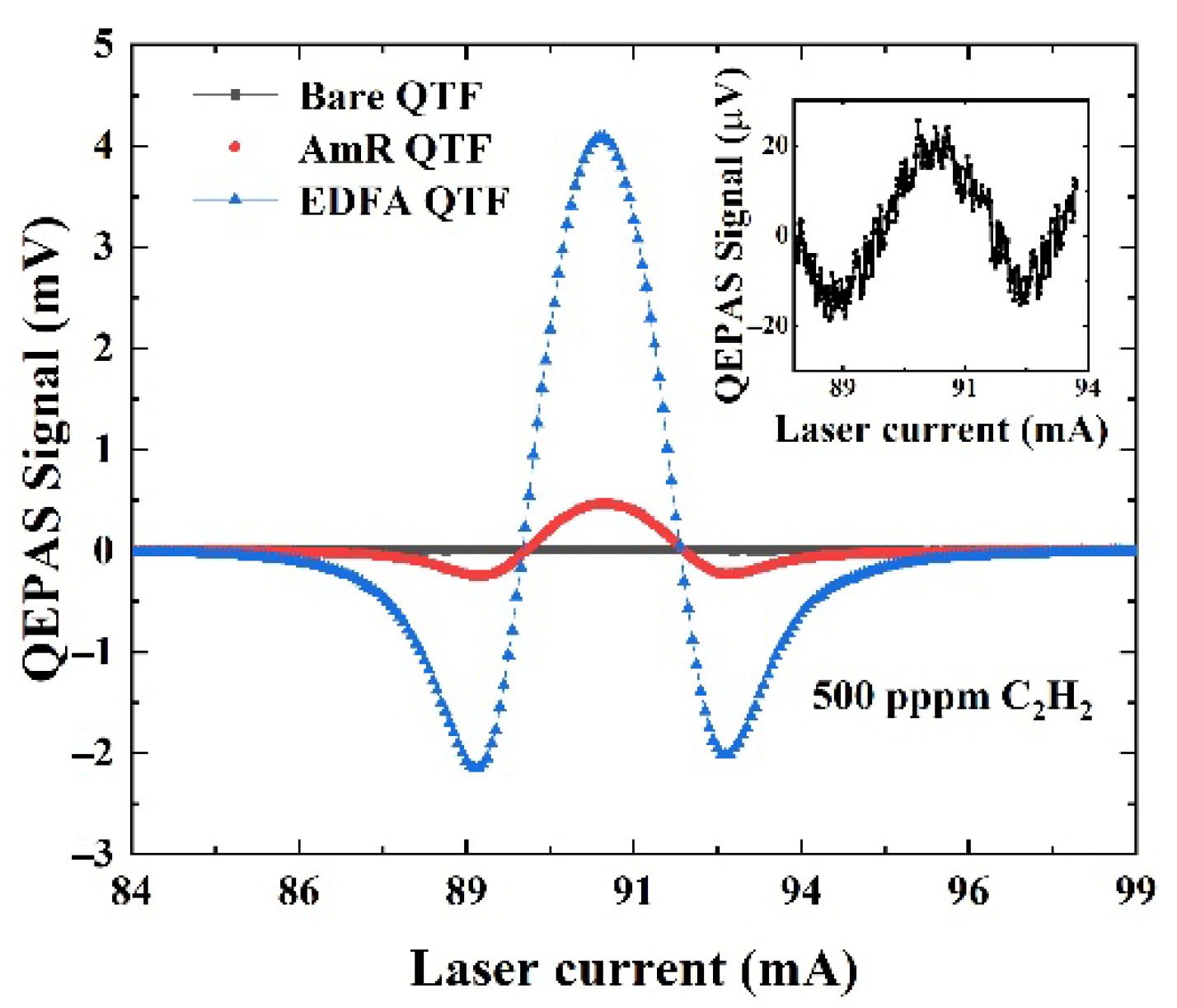High-Sensitivity Dynamic Detection of Dissolved Acetylene in Transformer Oil Based on High-Power Quartz-Enhanced Photoacoustic Spectroscopy Sensing System
Abstract
1. Introduction
2. Materials and Methods
3. Results
3.1. Selection of the Laser Wavelength
3.2. Experimental Setup
3.3. Optimization of the Laser Power
3.4. Optimization of the Modulation and Pressure
3.5. High-Power QEPAS System Performance Evaluation
3.6. Detection of the Dissolved Acetylene Gas in Oil
4. Discussion
Author Contributions
Funding
Institutional Review Board Statement
Informed Consent Statement
Data Availability Statement
Conflicts of Interest
Abbreviations
| QEPAS | Quartz-enhanced photoacoustic spectroscopy |
| EDFA | Erbium-doped fiber amplifier |
| DGA | Dissolved gas analysis |
| GC | Gas chromatography |
| FTIR | Fourier transform infrared spectroscopy |
| TDLAS | Tunable diode laser absorption spectroscopy |
| PAS | Photoacoustic spectroscopy |
| QTF | Quartz tuning fork |
| AmR | Acoustic micro-resonator |
| DFB | Distributed feedback |
| FWHM | Full width at half maximum |
| MDL | Minimum detection limit |
References
- Bakar, N.A.; Siada, A.A.; Islam, S. A review of dissolved gas analysis measurement and interpretation techniques. IEEE Electr. Insul. Mag. 2014, 30, 39–49. [Google Scholar] [CrossRef]
- Ma, G.; Wang, Y.; Qin, W.; Zhou, H.; Yan, C.; Jiang, J.; Ju, Y. Optical sensors for power transformer monitoring: A review. High Volt. 2021, 6, 367–386. [Google Scholar] [CrossRef]
- Susilo; Suwarno; Khayam, U.; Tsuchie, M.; Thein, M.; Hikita, M.; Saito, T. Study on Dissolved Gas Due Tue Thermally Degraded Insulating Paper in Transformer Oil. Procedia Technol. 2013, 11, 257–262. [Google Scholar]
- Sun, H.; Huang, Y.; Huang, C. A Review of Dissolved Gas Analysis in Power Transformers. Energy Procedia 2012, 14, 1220–1225. [Google Scholar] [CrossRef]
- Bustamante, S.; Manana, M.; Arroyo, A.; Castro, P.; Laso, A.; Martinez, R. Dissolved Gas Analysis Equipment for Online Monitoring of Transformer Oil: A Review. Sensors 2019, 19, 4057. [Google Scholar] [CrossRef]
- Zhou, S.; Iannuzzi, D. Immersion photoacoustic spectrometer (iPAS) for arcing fault detection in power transformers. Opt. Lett. 2019, 44, 3741–3744. [Google Scholar] [CrossRef] [PubMed]
- Fan, J.; Liu, Z.; Meng, A.; Yin, H.; Sun, Q.; Bin, F.; Jiang, Q. Characteristics of Tin Oxide Chromatographic Detector for Dissolved Gases Analysis of Transformer Oil. IEEE Access 2019, 7, 94012–94020. [Google Scholar] [CrossRef]
- Liu, N.; Xu, L.; Zhou, S.; Zhang, L.; Li, J. Simultaneous Detection of Multiple Atmospheric Components Using an NIR and MIR Laser Hybrid Gas Sensing System. ACS Sens. 2020, 5, 3607–3616. [Google Scholar] [CrossRef]
- Sun, H.; Ma, Y.; He, Y.; Qiao, S.; Yang, X.; Tittel, F.K. Highly sensitive acetylene detection based on a compact multi-pass gas cell and optimized wavelength modulation technique. Infrared Phys. Technol. 2019, 102, 103012. [Google Scholar] [CrossRef]
- Ma, G.; Zhao, S.; Jiang, J.; Song, H.; Li, C.; Luo, Y.; Wu, H. Tracing acetylene dissolved in transformer oil by tunable diode laser absorption spectrum. Sci. Rep. 2017, 7, 14961. [Google Scholar] [CrossRef]
- Jiang, J.; Wang, Z.; Han, X.; Zhang, C.; Ma, G.; Li, C.; Luo, Y. Multi-gas detection in power transformer oil based on tunable diode laser absorption spectrum. IEEE Trans. Dielectr. Electr. Insul. 2019, 26, 153–161. [Google Scholar] [CrossRef]
- Zhang, C.; He, Y.; Qiao, S.; Liu, Y.; Ma, Y. High-sensitivity trace gas detection based on differential Helmholtz photoacoustic cell with dense spot pattern. Photoacoustics 2024, 38, 100634. [Google Scholar] [CrossRef] [PubMed]
- Chen, K.; Guo, M.; Yang, B.; Jin, F.; Wang, G.; Ma, F.; Li, C.; Zhang, B.; Deng, H.; Gong, Z. Highly Sensitive Optical Fiber Photoacoustic Sensor for In Situ Detection of Dissolved Gas in Oil. IEEE Trans. Instrum. Meas. 2021, 70, 1–8. [Google Scholar] [CrossRef]
- Tang, X.; Wang, W.; Zhang, X.; Wang, E.; Li, X. On-line analysis of oil-dissolved gas in power transformers using Fourier trans form infrared spectrometry. Energies 2018, 11, 3192. [Google Scholar] [CrossRef]
- Munajad, A.; Subroto, C.; Suwarno. Fourier transform infrared (FTIR) spectroscopy analysis of transformer paper in mineral oil-paper composite insulation under accelerated thermal aging. Energies 2018, 11, 364. [Google Scholar] [CrossRef]
- Wang, J.; Wu, H.; Sampaolo, A.; Patimisco, P.; Spahnolo, V.; Jia, S.; Dong, L. Quartz-enhanced multiheterodyne resonant photoacoustic spectroscopy. Light Sci. Appl. 2024, 13, 77. [Google Scholar] [CrossRef]
- Shang, Z.; Wu, H.; Li, S.; Wang, G.; Sampaolo, A.; Patimisco, P.; Spahnolo, V.; Dong, L. Ppb-level mid-IR quartz-enhanced photoacoustic sensor for sarin simulant detection using a T-shaped tuning fork. Sens. Actuators B Chem. 2023, 390, 133937. [Google Scholar] [CrossRef]
- Xia, J.; Xia, Y.; Xiao, D.; Zhang, R.; Yu, N.; Liu, C. LAS-on-edge: A real-time laser absorption spectroscopic water vapor sensor on edge computing platforms. Sens. Actuators B Chem. 2024, 418, 136258. [Google Scholar] [CrossRef]
- Wang, H.; Zhang, J.; Sun, C.; Zhao, X.; Qi, H.; Chen, K. Miniaturized Fiber-Optic Photoacoustic Gas Sensor for Sub-ppb-Level Detection of Carbon Monoxide Based on Quantum Cascade Laser and Multipass Cell. Anal. Chem. 2025, 97, 8120–8128. [Google Scholar] [CrossRef]
- Wang, Q.; Wang, Z.; Kamimoto, T.; Deguchi, Y.; Wen, D.; Takahara, D. Applications of TDLAS based multi-species hydrocarbon measurement using a wide scanning range DFG laser. Results Eng. 2021, 12, 100297. [Google Scholar] [CrossRef]
- Wang, G.; Zhang, T.; Jiang, Y.; He, S. Compact photoacoustic spectrophone for simultaneously monitoring the concentrations of dichloromethane and trichloromethane with a single acoustic resonator. Opt. Express 2022, 20, 7053–7067. [Google Scholar] [CrossRef] [PubMed]
- Wang, G.; Meng, L.; Gou, Q.; Hanoune, B.; Crumeyrolle, S.; Fagniez, T.; Coeur, C.; Akiki, R.; Chen, W. Novel Broadband Cavity-Enhanced Absorption Spectrometer for Simultaneous Measurements of NO2 and Particulate Matter. Anal. Chem. 2023, 95, 3460–3467. [Google Scholar] [CrossRef]
- Zheng, H.; Liu, Y.; Lin, H.; Kan, R.; Patimisco, P.; Sampaolo, A.; Giglio, M.; Zhu, W.; Yu, J.; Tittel, F.; et al. Sub-ppb-level CH4 detection by exploiting a low-noise differential photoacoustic resonator with a room-temperature interband cascade laser. Opt. Express 2020, 28, 19446–19456. [Google Scholar] [CrossRef]
- Zheng, H.; Dong, L.; Sampaolo, A.; Wu, H.; Patimisco, P.; Yin, X.; Ma, W.; Zhang, L.; Yin, W.; Spahnolo, V.; et al. Single-tube on-beam quartz-enhanced photoacoustic spectroscopy. Opt. Lett. 2016, 41, 978–981. [Google Scholar] [CrossRef]
- Lv, H.; Zheng, H.; Liu, Y.; Yang, Z.; Wu, Q.; Lin, H.; Montano, B.; Zhu, W.; Yu, J.; Kan, R.; et al. Radial-cavity quartz-enhanced photoacoustic spectroscopy. Opt. Lett. 2021, 46, 3917–3920. [Google Scholar] [CrossRef]
- Xu, L.; Zhou, S.; Liu, N.; Zhang, M.; Liang, J.; Li, J. Multigas Sensing Technique Based on Quartz Crystal Tuning Fork-Enhanced Laser Spectroscopy. Anal. Chem. 2020, 92, 14153–14163. [Google Scholar] [CrossRef] [PubMed]
- Zhao, X.; Wang, H.; Xu, Y.; Li, C.; Qi, H.; Guo, M.; Peng, W.; Chen, K. Fiber-optic photoacoustic sensor with SF6 purity correction for decomposition derivative H2S based on 1f and 2f dual-modes. Appl. Phy. Lett. 2025, 126, 174101. [Google Scholar] [CrossRef]
- Wang, J.; Sun, C.; Wang, G.; Zou, M.; Tan, T.; Liu, K.; Chen, W.; Gao, X. A fibered near-infrared laser heterodyne radiometer for simultaneous remote sensing of atmospheric CO2 and CH4. Opt. Lasers Eng. 2020, 129, 106083. [Google Scholar] [CrossRef]
- Wu, H.; Dong, L.; Zheng, H.; Yu, Y.; Ma, W.; Zhang, L.; Yin, W.; Xiao, L.; Jia, S.; Tittel, F.K. Beat frequency quartz-enhanced photoacoustic spectroscopy for fast and calibration-free continuous trace-gas monitoring. Nat. Commun. 2017, 8, 15331. [Google Scholar] [CrossRef]
- Raza, M.; Xu, K.; Lu, Z.; Ren, W. Simultaneous methane and acetylene detection using frequency-division multiplexed laser absorption spectroscopy. Optics. Technol. 2022, 154, 10828. [Google Scholar] [CrossRef]
- Kosterev, A.A.; Bakhirkin, Y.A.; Curl, R.F.; Tittel, F.K. Quartz-enhanced photoacoustic spectroscopy. Opt. Lett. 2002, 27, 1902–1904. [Google Scholar] [CrossRef] [PubMed]
- Dong, L.; Kosterev, A.A.; Thomazy, D.; Tittel, F.K. QEPAS spectrophones: Design, optimization, and performance. Appl. Phys. B 2010, 100, 627–635. [Google Scholar] [CrossRef]
- Luo, H.; Wang, C.; Lin, H.; Wu, Q.; Yang, Z.; Zhu, W.; Zhong, Y.; Kan, R.; Yu, J.; Zheng, H. Helmholtz-resonator quartz-enhanced photoacoustic spectroscopy. Opt. Lett. 2023, 48, 1678–1681. [Google Scholar] [CrossRef] [PubMed]
- Ma, Y.; Hong, Y.; Qiao, S.; Lang, Z.; Liu, X. H-shaped acoustic micro-resonator-based quartz-enhanced photoacoustic spectroscopy. Opt. Lett. 2022, 47, 601–604. [Google Scholar] [CrossRef] [PubMed]
- Wei, T.; Zifarelli, A.; Russo, S.D.; Wu, H.; Menduni, G.; Patimisco, P.; Sampaolo, A.; Spagnolo, V.; Dong, L. High and flat spectral responsivity of quartz tuning fork used as infrared photodetector in tunable diode laser spectroscopy. Appl. Phys. Rev. 2021, 8, 041409. [Google Scholar] [CrossRef]
- Shang, Z.; Wu, H.; Wang, G.; Cui, R.; Li, B.; Gong, T.; Guo, G.; Qiu, X.; Li, C.; Dong, L. Robust and compact light-induced thermoelastic sensor for atmospheric methane detection based on a vacuum-sealed subminiature tuning fork. Photoacoustics 2025, 42, 100691. [Google Scholar] [CrossRef]
- Li, C.; Chen, K.; Zhao, J.; Qi, H.; Zhao, X.; Ma, F.; Han, X.; Guo, M.; An, R. High-sensitivity dynamic analysis of dissolved gas in oil based on differential photoacoustic cell. Opt. Lasers Eng. 2023, 161, 107394. [Google Scholar] [CrossRef]
- Shang, Z.; Li, S.; Li, B.; Wu, H.; Sampaolo, A.; Patimisco, P.; Spagnolo, V.; Dong, L. Quartz-enhanced photoacoustic NH3 sensor exploiting a large-prong-spacing quartz tuning fork and an optical fiber amplifier for biomedical applications. Photoacoustics 2022, 26, 100363. [Google Scholar] [CrossRef]
- Qiao, S.; He, Y.; Sun, H.; Patimisco, P.; Sampaolo, A.; Spagnolo, V.; Ma, Y. Ultra-highly sensitive dual gases detection based on photoacoustic spectroscopy by exploiting a long-wave, high-power, wide-tunable, single-longitudinal-mode solid-state laser. Light Sci. Appl. 2024, 13, 100. [Google Scholar] [CrossRef]
- Miklos, A. Acoustic Aspects of Photoacoustic Signal Generation and Detection in Gases. Int. J. Thermophys. 2015, 36, 2285–2317. [Google Scholar] [CrossRef]






Disclaimer/Publisher’s Note: The statements, opinions and data contained in all publications are solely those of the individual author(s) and contributor(s) and not of MDPI and/or the editor(s). MDPI and/or the editor(s) disclaim responsibility for any injury to people or property resulting from any ideas, methods, instructions or products referred to in the content. |
© 2025 by the authors. Licensee MDPI, Basel, Switzerland. This article is an open access article distributed under the terms and conditions of the Creative Commons Attribution (CC BY) license (https://creativecommons.org/licenses/by/4.0/).
Share and Cite
Wu, Y.; Ma, T.; Liu, C.; Fan, Y.; Shi, S.; Guo, S.; Wang, Y.; Xu, X.; Guo, G.; Qiu, X.; et al. High-Sensitivity Dynamic Detection of Dissolved Acetylene in Transformer Oil Based on High-Power Quartz-Enhanced Photoacoustic Spectroscopy Sensing System. Photonics 2025, 12, 713. https://doi.org/10.3390/photonics12070713
Wu Y, Ma T, Liu C, Fan Y, Shi S, Guo S, Wang Y, Xu X, Guo G, Qiu X, et al. High-Sensitivity Dynamic Detection of Dissolved Acetylene in Transformer Oil Based on High-Power Quartz-Enhanced Photoacoustic Spectroscopy Sensing System. Photonics. 2025; 12(7):713. https://doi.org/10.3390/photonics12070713
Chicago/Turabian StyleWu, Yuxiang, Tiehua Ma, Chenhua Liu, Yashan Fan, Shuai Shi, Songjie Guo, Yu Wang, Xiangjun Xu, Guqing Guo, Xuanbing Qiu, and et al. 2025. "High-Sensitivity Dynamic Detection of Dissolved Acetylene in Transformer Oil Based on High-Power Quartz-Enhanced Photoacoustic Spectroscopy Sensing System" Photonics 12, no. 7: 713. https://doi.org/10.3390/photonics12070713
APA StyleWu, Y., Ma, T., Liu, C., Fan, Y., Shi, S., Guo, S., Wang, Y., Xu, X., Guo, G., Qiu, X., Shang, Z., & Li, C. (2025). High-Sensitivity Dynamic Detection of Dissolved Acetylene in Transformer Oil Based on High-Power Quartz-Enhanced Photoacoustic Spectroscopy Sensing System. Photonics, 12(7), 713. https://doi.org/10.3390/photonics12070713




